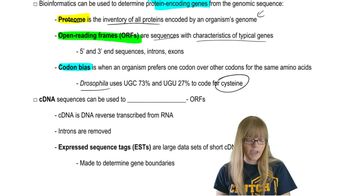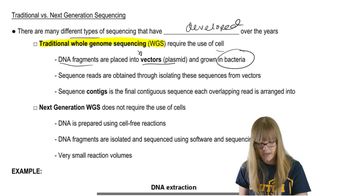Table of contents
- 1. Introduction to Genetics51m
- 2. Mendel's Laws of Inheritance3h 37m
- 3. Extensions to Mendelian Inheritance2h 41m
- 4. Genetic Mapping and Linkage2h 28m
- 5. Genetics of Bacteria and Viruses1h 21m
- 6. Chromosomal Variation1h 48m
- 7. DNA and Chromosome Structure56m
- 8. DNA Replication1h 10m
- 9. Mitosis and Meiosis1h 34m
- 10. Transcription1h 0m
- 11. Translation58m
- 12. Gene Regulation in Prokaryotes1h 19m
- 13. Gene Regulation in Eukaryotes44m
- 14. Genetic Control of Development44m
- 15. Genomes and Genomics1h 50m
- 16. Transposable Elements47m
- 17. Mutation, Repair, and Recombination1h 6m
- 18. Molecular Genetic Tools19m
- 19. Cancer Genetics29m
- 20. Quantitative Genetics1h 26m
- 21. Population Genetics50m
- 22. Evolutionary Genetics29m
15. Genomes and Genomics
Sequencing the Genome
Problem 1b
Textbook Question
You have discovered a new species of archaea from a hot spring in Yellowstone National Park. After growing a pure culture of this organism, what strategy might you employ to sequence its genome?
 Verified step by step guidance
Verified step by step guidance1
Step 1: Isolate the DNA from the pure culture of the archaea to obtain a sufficient quantity of high-quality genomic DNA.
Step 2: Choose a sequencing technology suitable for the genome size and complexity, such as Illumina for short reads or PacBio/ONT for long reads.
Step 3: Prepare a sequencing library by fragmenting the DNA and adding necessary adapters for the chosen sequencing platform.
Step 4: Sequence the DNA fragments using the selected sequencing technology to generate raw sequence data.
Step 5: Assemble the raw sequence data into a complete genome sequence using bioinformatics tools, ensuring to address any gaps or errors in the assembly.
Recommended similar problem, with video answer:
 Verified Solution
Verified SolutionThis video solution was recommended by our tutors as helpful for the problem above
Video duration:
1mPlay a video:
Was this helpful?
Key Concepts
Here are the essential concepts you must grasp in order to answer the question correctly.
Genome Sequencing Techniques
Genome sequencing involves various techniques to determine the complete DNA sequence of an organism's genome. Common methods include Sanger sequencing, which is suitable for smaller genomes, and next-generation sequencing (NGS), which allows for rapid sequencing of large genomes. Understanding these techniques is crucial for selecting the appropriate method for sequencing the genome of the newly discovered archaea.
Recommended video:
Guided course

Sequencing Overview
Archaea Characteristics
Archaea are a distinct group of microorganisms that differ from bacteria and eukaryotes in their genetic, biochemical, and physiological properties. They often thrive in extreme environments, such as hot springs, and possess unique adaptations, such as distinct membrane lipids and ribosomal RNA sequences. Recognizing these characteristics is essential for understanding the specific challenges and considerations when sequencing their genomes.
Recommended video:
Guided course

Cancer Characteristics
Bioinformatics in Genomics
Bioinformatics is the application of computational tools to manage, analyze, and interpret biological data, particularly in genomics. After sequencing the genome, bioinformatics plays a critical role in assembling the sequence, annotating genes, and comparing the genome to other organisms. Familiarity with bioinformatics tools and databases is vital for effectively analyzing the genomic data obtained from the new archaeal species.
Recommended video:
Guided course

Bioinformatics

 8:55m
8:55mWatch next
Master Sequencing Overview with a bite sized video explanation from Kylia Goodner
Start learning



